Part 148: Lesson 3: The Unconscious: Beyond Space-Time
-Specialist-
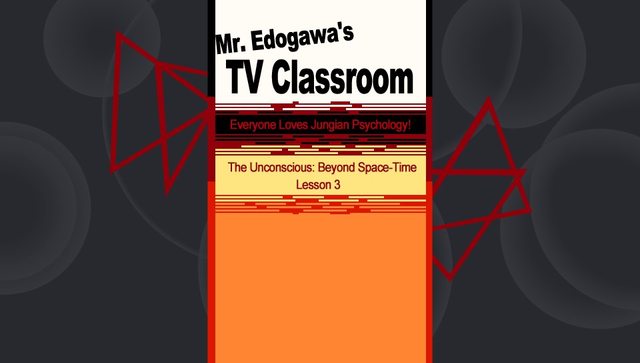
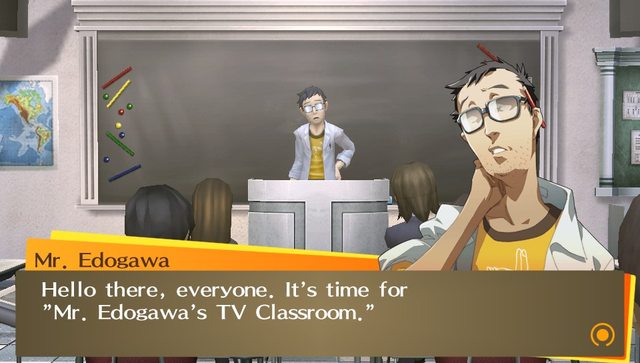

"Everyone Loves Jungian Psychology!" An invitation to the you that you don't know. We're already on our third installment: "The Unconscious: Beyond Space and Time." Are you getting everything so far? You're not fast-forwarding through my lectures, are you? Eeeheehee...Let's begin the lecture. Progredio ado rukem shiderem...
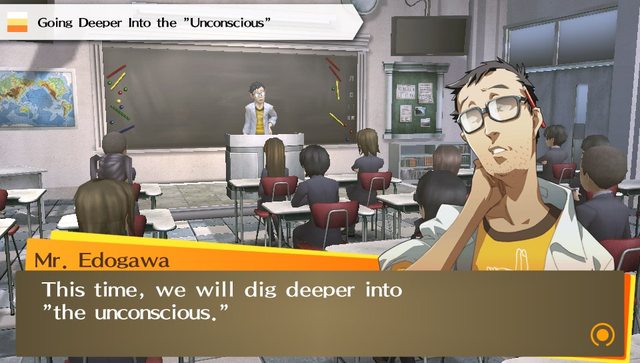

Last time, I explained the existence of the unconscious. But to "exist" implies that there is a process through which it is "created." Today's lesson will follow this process behind the creation of the unconscious. By doing so, we will close in on the schocking core of Jungian psychology.
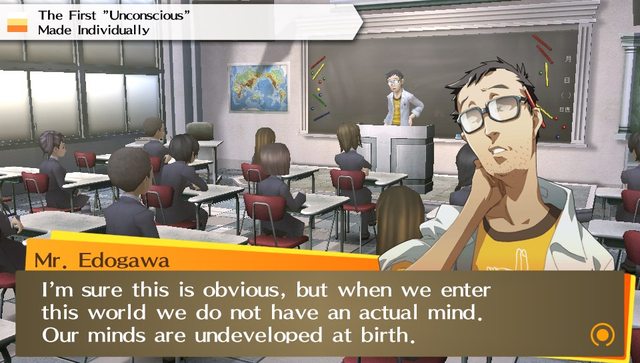

As a child grows, his mind develops, and his unconscious forms. It's easy to understand that the growth of the body and the growth of the mind are connected, right? But how exactly is the unconscious created? From the moment the unconscious was acknowledged to exist, it was believed to come from "personal experiences." It doesn't come from nowhere; the unconscious is created through what a person experiences as he lives his life...In a sense, it's a natural idea. As you build experience, you accumulate knowledge and emotionss, in other words, memories and recollections...It was thought that the mental energy from those memories gather in a realm outside of the conscious, creating the "unconscious." Did you get that? Let me explain it in simpler terms...As people live their lives, they experience many things, but it's not like they remembe everything that happened to them. There are memories you want to keep, but sometimes too much time passes. There are "old memories"...And "abandoned memories," memories that you actively want to forget. To put it visually, the "corpses" of these memories pile up, forming the soil known as the unconscious. Or something like that. At any rate, memories that fall from or are pushed out of the conscious form the unconscious...That's the common theory. Regarding these "abandoned memories" that I mentioned just now: in psychology, this mechanism is called "suppression." It's the central subject of Freudian psychoanalysis, so let me give you a brief introduction.
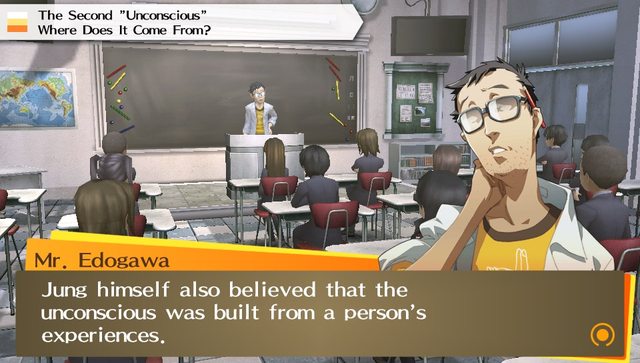

...But, as he observed his patients, he encountered an unconscious that could not be explained via personal experience. Scenery the people had never seen, creatures that don't exist, events that never happened. Patients spoke of experiences they didn't have. He couldn't just file them under "nonsense" or "reconstructed memory," so he thought about why things like this happened...Then he realized something when he found that one patient's delusion was similar to an uncommon foreign myth. "Man's unconscious is shared...!" It was a groundbreaking thought, and Jung continued to test his theory. He saw several other cases in which the patient's delusions were similar to myths and legends...The existence of similar myths among regions that could have never met also points to this shared unconscious. With this proof, Jung advocated his theory of the "collective unconscious." Let's take a look at the structure of the mind, split between the conscious and the unconscious.
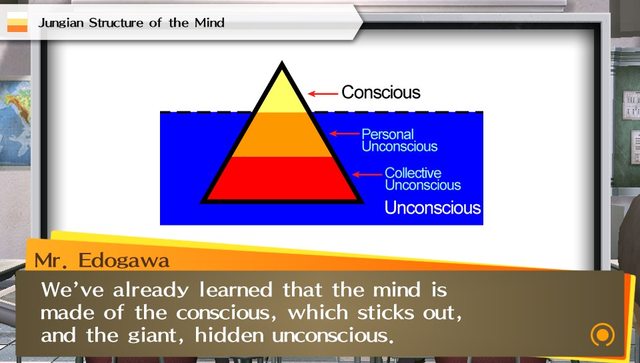

The unconscious is separated into the part that is created by that person's singular life, and the part that is shared. This middle part here is the "personal unconscious," formed by the individual's personal experiences. And, at the very bottom is the "collective unconscious," the part shared between all people. We just talked about that. The minds of all people living everywhere, are shared. It's a very strange thought, this collective unconscious...But it is the foundation of the mind, with you since birth. Because everyone's mind develops from the same foundation, this collective unconscious appears to be "shared."
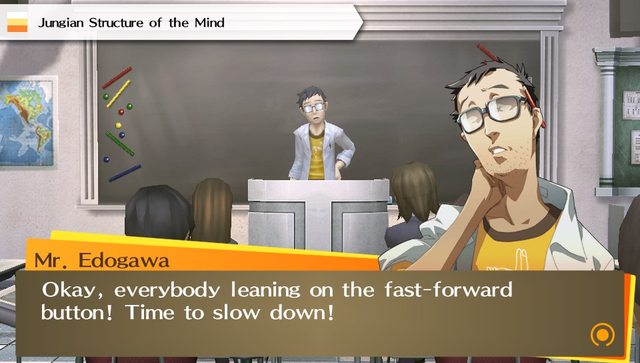

Hit "Play!" This is the important quiz. I'm not sure how someone who skipped the lesson can expect to answer it, but we'll see...Are you ready? All right, I ask thee. Jung believed the mind was made up of the "collective unconscious," the "personal unconscious," and the "conscious." A: Collective unconscious, B: Personal unconscious, C: Conscious. Put them in order from deepest to highest.

A -> B -> C

Okay, that was correct. Multiple choice quizzes sure make problems easy, don't they? If you can just get the order of the unconsciousnesses right, you'll be able to get by in life...Now then, it looks like our time here is over. In this lesson, you learned about the personal unconscious and the collective unconscious. In the next lesson, by looking at the collective unconscious as the "foundation for the mind"...We will study something within our own minds. And, that's it for today.


 "Everyone Loves Jungian Psychology!" An invitation to the you that you don't know. We're already on our third installment: "The Unconscious: Beyond Space and Time." Are you getting everything so far? You're not fast-forwarding through my lectures, are you? Eeeheehee...Let's begin the lecture. Progredio ado rukem shiderem...
"Everyone Loves Jungian Psychology!" An invitation to the you that you don't know. We're already on our third installment: "The Unconscious: Beyond Space and Time." Are you getting everything so far? You're not fast-forwarding through my lectures, are you? Eeeheehee...Let's begin the lecture. Progredio ado rukem shiderem...
 Last time, I explained the existence of the unconscious. But to "exist" implies that there is a process through which it is "created." Today's lesson will follow this process behind the creation of the unconscious. By doing so, we will close in on the schocking core of Jungian psychology.
Last time, I explained the existence of the unconscious. But to "exist" implies that there is a process through which it is "created." Today's lesson will follow this process behind the creation of the unconscious. By doing so, we will close in on the schocking core of Jungian psychology.
 As a child grows, his mind develops, and his unconscious forms. It's easy to understand that the growth of the body and the growth of the mind are connected, right? But how exactly is the unconscious created? From the moment the unconscious was acknowledged to exist, it was believed to come from "personal experiences." It doesn't come from nowhere; the unconscious is created through what a person experiences as he lives his life...In a sense, it's a natural idea. As you build experience, you accumulate knowledge and emotionss, in other words, memories and recollections...It was thought that the mental energy from those memories gather in a realm outside of the conscious, creating the "unconscious." Did you get that? Let me explain it in simpler terms...As people live their lives, they experience many things, but it's not like they remembe everything that happened to them. There are memories you want to keep, but sometimes too much time passes. There are "old memories"...And "abandoned memories," memories that you actively want to forget. To put it visually, the "corpses" of these memories pile up, forming the soil known as the unconscious. Or something like that. At any rate, memories that fall from or are pushed out of the conscious form the unconscious...That's the common theory. Regarding these "abandoned memories" that I mentioned just now: in psychology, this mechanism is called "suppression." It's the central subject of Freudian psychoanalysis, so let me give you a brief introduction.
As a child grows, his mind develops, and his unconscious forms. It's easy to understand that the growth of the body and the growth of the mind are connected, right? But how exactly is the unconscious created? From the moment the unconscious was acknowledged to exist, it was believed to come from "personal experiences." It doesn't come from nowhere; the unconscious is created through what a person experiences as he lives his life...In a sense, it's a natural idea. As you build experience, you accumulate knowledge and emotionss, in other words, memories and recollections...It was thought that the mental energy from those memories gather in a realm outside of the conscious, creating the "unconscious." Did you get that? Let me explain it in simpler terms...As people live their lives, they experience many things, but it's not like they remembe everything that happened to them. There are memories you want to keep, but sometimes too much time passes. There are "old memories"...And "abandoned memories," memories that you actively want to forget. To put it visually, the "corpses" of these memories pile up, forming the soil known as the unconscious. Or something like that. At any rate, memories that fall from or are pushed out of the conscious form the unconscious...That's the common theory. Regarding these "abandoned memories" that I mentioned just now: in psychology, this mechanism is called "suppression." It's the central subject of Freudian psychoanalysis, so let me give you a brief introduction.
 ...But, as he observed his patients, he encountered an unconscious that could not be explained via personal experience. Scenery the people had never seen, creatures that don't exist, events that never happened. Patients spoke of experiences they didn't have. He couldn't just file them under "nonsense" or "reconstructed memory," so he thought about why things like this happened...Then he realized something when he found that one patient's delusion was similar to an uncommon foreign myth. "Man's unconscious is shared...!" It was a groundbreaking thought, and Jung continued to test his theory. He saw several other cases in which the patient's delusions were similar to myths and legends...The existence of similar myths among regions that could have never met also points to this shared unconscious. With this proof, Jung advocated his theory of the "collective unconscious." Let's take a look at the structure of the mind, split between the conscious and the unconscious.
...But, as he observed his patients, he encountered an unconscious that could not be explained via personal experience. Scenery the people had never seen, creatures that don't exist, events that never happened. Patients spoke of experiences they didn't have. He couldn't just file them under "nonsense" or "reconstructed memory," so he thought about why things like this happened...Then he realized something when he found that one patient's delusion was similar to an uncommon foreign myth. "Man's unconscious is shared...!" It was a groundbreaking thought, and Jung continued to test his theory. He saw several other cases in which the patient's delusions were similar to myths and legends...The existence of similar myths among regions that could have never met also points to this shared unconscious. With this proof, Jung advocated his theory of the "collective unconscious." Let's take a look at the structure of the mind, split between the conscious and the unconscious.
 The unconscious is separated into the part that is created by that person's singular life, and the part that is shared. This middle part here is the "personal unconscious," formed by the individual's personal experiences. And, at the very bottom is the "collective unconscious," the part shared between all people. We just talked about that. The minds of all people living everywhere, are shared. It's a very strange thought, this collective unconscious...But it is the foundation of the mind, with you since birth. Because everyone's mind develops from the same foundation, this collective unconscious appears to be "shared."
The unconscious is separated into the part that is created by that person's singular life, and the part that is shared. This middle part here is the "personal unconscious," formed by the individual's personal experiences. And, at the very bottom is the "collective unconscious," the part shared between all people. We just talked about that. The minds of all people living everywhere, are shared. It's a very strange thought, this collective unconscious...But it is the foundation of the mind, with you since birth. Because everyone's mind develops from the same foundation, this collective unconscious appears to be "shared."
 Hit "Play!" This is the important quiz. I'm not sure how someone who skipped the lesson can expect to answer it, but we'll see...Are you ready? All right, I ask thee. Jung believed the mind was made up of the "collective unconscious," the "personal unconscious," and the "conscious." A: Collective unconscious, B: Personal unconscious, C: Conscious. Put them in order from deepest to highest.
Hit "Play!" This is the important quiz. I'm not sure how someone who skipped the lesson can expect to answer it, but we'll see...Are you ready? All right, I ask thee. Jung believed the mind was made up of the "collective unconscious," the "personal unconscious," and the "conscious." A: Collective unconscious, B: Personal unconscious, C: Conscious. Put them in order from deepest to highest. A -> B -> C
A -> B -> C Okay, that was correct. Multiple choice quizzes sure make problems easy, don't they? If you can just get the order of the unconsciousnesses right, you'll be able to get by in life...Now then, it looks like our time here is over. In this lesson, you learned about the personal unconscious and the collective unconscious. In the next lesson, by looking at the collective unconscious as the "foundation for the mind"...We will study something within our own minds. And, that's it for today.
Okay, that was correct. Multiple choice quizzes sure make problems easy, don't they? If you can just get the order of the unconsciousnesses right, you'll be able to get by in life...Now then, it looks like our time here is over. In this lesson, you learned about the personal unconscious and the collective unconscious. In the next lesson, by looking at the collective unconscious as the "foundation for the mind"...We will study something within our own minds. And, that's it for today.